We'd be happy to put few of them in this gallery along with a short project description.
Old contacts with spring switches:

Cleaning:

Support for the MIDI encoder board:

Reed contacts and closing:

Closing, the final result:

Following is short project description as submitted by Mr. Mainieri:
Pedalboard Restoring of GEM liturgic organ
By Francesco Mainieri and components by Largonet (MIDI Boutique).
Sept-Oct 2014
The pedalboard is part of a GEM organ, that was fully disassembled.
Estimated age: 40+ years. The electronic circuits are completely broken and rusty,
made with Germanium transistors and positive ground, fully analog.
In the previous electronic, each key controlled multiple oscillators and filters.
The pedalboard was monophonic, and mechanically is concave and radial.
It needed a full restoration, including the mechanical parts.
The adopted solution uses Largonet (MIDI Boutique) microcontroller board:
the mpc32xrs pedalboard MIDI encoder and the csr32p Reed-contact system.
The testing was implemented with ad hoc program made by myself in Visual Basic,
running under Windows 7.
It captures the midi data and displays them in text and keyboard format in real time.
The sound generator is the Roland expander SC8850.
Here some photos of the pedalboard during the work proceeding.


Mr. Pouhier converted an old analogue
Böhm console dated 1978 to MIDI
for using with Hauptwerk 4,
jOrgan and GrandOrgue VPO's

Mr. Teycheney equipped his 3M/P console with mkcv64smf-bundle#3 for keyboards and mpc32xrs-bundle#2 for pedalboard. Following is his short description of the system:
3 x Fatar heavy touch keyboards;
Intel CoreI5 3,4Ghz;
Asus P8Z77 mother board;
128G SDD.
Loads Windows 8 in less than 30 seconds;
I purchased Haupwerk 4, but I use
GrandOrgue with the excellent (and free....!)
Burea Church sample set by Lars Palo.
Audio transducer is a Senheiser HD650 headphone
or an old Harmann Kardon TA600 with a
pair of Cabasse loudspeakers.



wooden parts and carving and key mechanics inside.
He built his own opto-switch contact system circuitry, involving two opto switches
per key, read by mkcv64smf encoder, and clever mechanism to make key
movement optically readable.
Few drawings of the mechanical and keying parts can be found here,
courtesy of Mr. Verheijen.
and refurbished organ pedalboard,
converted to MIDI using mkc64x.
Mr. Robinson built nice 3M/1P wooden Hauptwerk console with three Fatar touch sensitive manuals,
using mkcv64smf-bundle#3 for the manuals and expression pedals,
mpc64up for stops/pistons.
More pictures of this project can be found on Picasa.

in his Hauptwerk console for indicating Hauptwerk' status.
Full project description: here.


mdec64dd-p (SAM) , mi485 - bundle#1 , ms1-5 and hwlcd4 - bundle#1
for remote (safe distance over 500 feet / 150 m)
control of real firework show via UTP cable.
More photos to come soon.
by Native Instruments using mdbc24
returned to life using mpc64up and mdec32br-n with customized firmware

The console

The malfunctioning stop control module

The "dead" stops

The mpc64up and mdec32br-n in position

The (messy) re-wiring to the new units

The stops fully working!
Following is brief project description
submitted by Mr. Williams:
On purchasing a second hand Viscount Oratorio IV
(one of only two in the UK), the controller board for the illuminated
stops for the Great and Choir/Positiv divisions failed.
However, a custom programmed mcp64up encoder allows stop
movements to send System Exclusive messages to trigger sound
patch changes, and a mdec32br-n decoder (with custom firmware
again thanks to Jordan) allows the stops to illuminate based on the
same System Exclusive messages as well as the General Cancel piston
System Exclusive.
The units seamlessly integrate into the organ's data chain,
rendering the organ stops as good as new.
Without Jordan's fantastic products
half of this organ would be useless!
Mr. Brodzikowski of Magnus Organy company
built their new Hauptwerk console using various MIDI Boutique devices.
Followig is the specification as submitted on Hauptwerk Forum:
- 4 wooden manuals
- 32 glowing pistons
- Wooden pedalboard 30 keys, parallel. BDO standard.
- 80 registers (with automatic). 40 on each side.
- Interchangeable plates with the names of registers.
- Cressendo roller, and sweel pedal.
- 7 toepistons.
- Adjustable Bench.
- LED lighting on the music rack and pedalboard.
- Two 2x16 display
- Wooden casing.
- Sound: 10 double columns. (60 speakers).
- EASY-ON - the whole instrument turns on one button.
The computer controls everything, including the sound system and LED lighting.
- Midibutique MIDI implementation. (Thanks Jordan)
- Computer: Intel Core i7, 24GB RAM (1600MHz), 2x 120 GB SSD (RAID),
2x delta1010lt. - Time to fully boot (zwolle DRY, 24bit, uncompressed: 23s)
- Sample sets: Zwolle v.2 and Caen v.2 (Sonus Paradisi).
There will be "Krzeszow" also, as soon as the DRY version will be available
two mdec80br-n deecoders




Misha V. Stefanuk, organist and composer from Atlanta GA
built his touring theatre organ in 2011.
The 80 SAM stop keys from Kimber Alen are controlled using mdec80br-n decoders.
For more information go to original site:
www.stefanuk.com
The organ is a Compton 357CP from 1961
It belong to my electrostatic organ collection with Compton, Dereux, Parie and Wurlitzer organs.
See allso my website www.parie.nl.
to MIDI using mpc32xrs-bundle#2.
The pedalboard together with two M-Audio keyboards form
organ console for controlling Hauptwerk4.
Stops are controlled from Touch-scrreen.
More details about construction: on this video.
converted to MIDI using b4ce1x
controlling B4 II by Native Instruments





Mr. Perrot built this Hammond B3 replica console from scratch,
using b4ce1x controller to drive the NI B4II Hammond virtual organ.
Keyboards are OEM Fatar waterfall manual TP 80,
drawbars came from an old out of service Hammond.
For more detauls please follow the original blog of this project.




to MIDI using mpc32xrs-bundle#1.
The pedalboard together with third-party MIDI keyboard controller
is being used for playing Hauptwerk VPO.

with customized firmware for controlling TBX1 tuning box by H-Pi.
The full story can be found in H-Pi blog.

Mr. Erker built Christmas light system for his house, using mdec64ddn.
The decoration consists of 5000-6000 LEDs in 46 individually controllable fairy lights:
10 Windows in white
7 frames in Red
7 frames in White
2 Bells in orange
1 Santa Claus colored
1 red
1 green
1 blue
15 christmas trees in white
1 Snowfall simulation (consisting of 8 white chains)




Mr. Bradfield converted his pedalboard using mpc32xrs-bundle#1.
Original idea for installing Reed contacts on plates of clear acryllic glass
so that they could be easier adjusted to their right position and orientation.
The idea came from Mr. Bradfield Sr. and might be useful
for many other users of mpc32xrs.
More details can be seen on Mr. Bradfield's Facebook gallery.
building various musical robot applications.
More clips on YouTube:
clip 1
clip 2
clip 3



An pedalboard belonging to Viscount Domus 8
analogue organ was converted to MIDI using mpc32xrs .
The purpose of that project was to make possible dual use of this pedalboard
without losing its original function as part of Viscount console.
Now it can be used on its original place as well as part of stand-alone
dual-manual Hauptwerk - dedicated MIDI console.
More details can be found on original project site.






Mr. Werner built his pedalboard from scratch and equipped it with original contact
system based on magnetically-operated solid state Hall switches (data sheet here).
These Hall switches can be used with mpc32xrs directly and don't require any customization.
The only signifficant difference between them and Reed contacts is that Hall switches require power.
In exchange, they are more reliable and proof to vibrations and shocks
as there are ni moving parts inside them.
4 Fatar Manuals, Compton pedalboard, 3 Swell pedals, 20 Foot pistons,
114 Thumb Pistons, & 34 Lighted Coupler switches put together in a
nice wooden console dedicated to Hauptwerk VPO.
More detailed pictures as well as technical drawings about this project can be found here.
UPDATE August 2014
Last two photos show the new look of this console updated as follows:
Restored woodcored Compton Keyboards with natural coverings,
32 Coupler switches, Compton pedalboard, 3 Swell pedals,
20 Foot pistons, 114 Thumb Pistons
for controlling Hauptwerk
as well as Mititzer
using hwce-bundle#3






This time Mr. Arnstein (Arnstein Organ Company) built their Opus 2 based on Allen Sheraton 12.
The console now features hwce-bundle#3, a dual core PC built into the case, Emu 0404 audio card, touchscreen, and Miditizer and Hauptwerk for organ emulation software.
More info and photos can be found in builder's Facebook profile.
using two mkc64x encoders and two mdec128br-p (SAM) decoders




Mr. Russell built an organ console based on four MidiWorks keyboards and pedal board.
The 77 Syndyne drawknobs for stops,
25 OSI moving tabs for couplers and 14 pistons were MIDI-interfaced using
two mkc64x encoders for scanning their contacts and
two mdec128br-p (SAM) decoders for driving their solenoids.
This console is supposed to be used with Hauptwerk VPO.





The Fischer Organ Company is specialized in renovation and MIDI conversion of church organs.
They have been using various MIDI Boutique products for two of their projects:
St. Boniface RC, Erie, PA
and
Asbury United Methodist, Erie, PA
Both organs have been MIDI-fied for use with Hauptwerk VPO.



The following short description of the project was kindly supplied by Mr. Stanoszek:
This 37 note chromatic reiterating glockenspiel F-F is electrically operated from a 13.25VDC @ 11 amp power supply. Unit is polyphonic to 6 notes. The conversion was done with an SMP Record/Play MIDI unit; driving an mdec 48br-pd; MIDI decoder box with 48 power FET drivers. A high speed 1 amp/400piv diode is across each coil to suppress any inductive kickback. 4 ferrite beads are around each of the #18 wire connections in the bottom to suppress any RF coming from the coils into the decoder. 4 ten element bar graf display is connected from the 13.25 vdc supply, the other side goes to a 1k 1/4watt resistor to the FET. The unit sounds best when a 2 finger melody is played.
for controlling Hauptwerk virtual organ




Mr. Russ gave second life to an 30-year-old Ahlborn-Lipp organ console
by installing hwce-bundle#1 MIDI interface in it.
The re-born MIDI console will be used for controlling
Hauptwerk virtual organ and is still in development.
More pictures are expected upon finishing the project...
various objects using mdec64dd-p




Mr. Underwood (aka Glatze) is a musician, sound artist and instrument designer.
Amongst his various creative art activities, he builds unusual instruments.
One of them is the MIDI Octopus.
The following short description was taken from the original project's site
http://www.samski.net/midi-octopus.
The midi-octopus is a modular midi interface, designed to allow midi sequencing of objects in the local environment. With it, you can make all physical objects within the performance environment (chairs, lampshades, windows etc...) midi sequenceable.
Since March 2010 the new MIDI Octopus site can be found at
http://www.midi-octopus.co.uk
More information about other Mr. Underwood projects can be found at http://www.mrunderwood.co.uk


Mr. van Helden expanded it by adding a good number of drawstops,
converted to MIDI using hwce-bundle#2 which enabled
the console for use with mighty Hauptwerk samplesets.
Instead of using Reed switches or any other standard contacts
Mr. Cristiani made his own contact system using silver coated sprigns for keys and
silver coated wire for the busbar (well-seen on top photo).





The instrument is self-contained and foldable for easy transportation.
The full desfription of the project including block diagrams and
detail drawings can be found on original project site.



Mr. Fagerjord made an Hauptwerk console including wooden pedalboard of very high quality though he claimed he was no craftsman. The pedalboard was MIDI-fied using mpc32xrs MIDI encoder and csr32p contact system. The full story can be read on project's original site. Again, an very original way of installing the Reed contact system was applied (see page 5 of the project).





Mr. Spencer built his organ console from scratch. For the the pedalboard he used mpc32xrs MIDI encoder and csr32p contact system. The actuating magnets were attached to pedals in very original way using screws allowing adjustment.
The full description of this project can be found on its original site.
Included are also detailed technical description of the organ console construction (pdf)
as well as bench design desription (pdf) that might be useful for anybody wanting to build their own organ console according to standard specifications.







The next Hammond console brought back to life by MIDI conversion and B4 software by Native Instruments.
Jeff and his soon Peter (on photos) took an b4ce1x and did the scanmatrix and drawbars wiring himself.




The following excerpt was taken from project's original site:
We picked up an inexpensive old Theater Organ and have converted it to MIDI to run the Hauptwerk virtual organ software. It's nice to have a keyboard instrument in the house again. This Rodgers 321A "Trio" circa '75 is now playing the Neil Jensen Connoisseur Series 3/11 theater pipe organ samples.
More pictures of this project in progress can be seen in Mr. Kinkennon's photo gallery.
using mpc32xrs








The second step was mastering a nice bench.
And the third step was mastering a console for housing the two MIDI manuals.
synthesis model using mkc-x



The interface was built into an telephone call box for more
convenient and natural operation.
More information can be found in original project page,
as well as video-audio demonstration clip (Quicktime video).
for controlling MyOrgan virtual organ
using hwce-bundle#3

The full specificastion is shown in original publication.
Mr. Riedl designed an original solution for using the origiinal multi-contact Swell/Expression pedal assembly with resistor network instead of potentiometer.
The schematic can be dowloaded from original site or from here.




An old Reisner organ console was entirely restored and MIDI-fied by
Mr. Arnstein using hwce-bundle#3.
As a result Mr. Arnstein got an nice 3-Manual & Pedal organ powered by
Hauptwerk running the original St. Anne's samples as well as
number of sample sets from Milan Digital Audio.
The full story of this project is quite interesting and is available on
Mr. Arnstein's site dedicated to ths project.
Recently few audio (.mp3) files were added.
The first official concert of the organ presented by
Dallas Organ Society (D.O.S.)
has been held on March 15th 2009.
Here is the original event announce.
Following are two YouTube videoclips from this event.
At the bottom Mr. Arnstein himself can be seen playing a musical piece.



An extremely original approach to converting key events to MIDI events without any key contacts, invented by Mr. Caude Oudet. For keeping the pipe organ manuals and pedalboard intact, instead of key contacts, airpressure transducers were used, with input ports attached to air canals (French:gravures) using flexible plastic tube. A set of pressure transducers by German manufacturer Sensor Technics GmbH was used for this purpose.
The MIDI encoder electronics made by MIDI Boutique included hwce plus custom-built boards replacing standard KeyMux64 boards, for allowing airpressure input instead of key contact input (bottom picture). Later, an ahltemp autotuning circuit was added to the system, to allow keeping Ahlborn Archive module tuned to organ pipes over a wide range of temperatures.
The credits for this original project (after Mr. Oudet's e-mail) go to:
• to Mr. Andreas Ladach at Instrumente LADACH in Germany who had this small used organ available for us
• to you (and your unlimited patience!)
• to the organ builder Giroud & successeurs in Grenoble (mainly his boss Mr. Jacques Nonnet), France, who has nicely installed the electronics and connected the mini tubes to the air canals,
• and a little to me who has discovered the possibilities of the pressure sensors produced by SensorTechnics
Recently Mr. Oudet has submitted on Hauptwerk Forum an article describing this project.
The document can also be downloaded from here.





The following notes about this project were supplied by Mark Williams. We do encourage our customers to send us project descriptions for posting them here together with original photo materials.
This is a 3-manual Hauptwerk organ designed and constructed by Mark K. Williams of Savannah, Georgia (USA) for his home. The organ utilizes a duo-core PC with 8GB RAM and WinXP64. MIDI interface hardware is from Largonet's MIDI Gadgets Boutique of Bulgaria (really nice boards). The main goal in the design and construction of the organ was to provide a replica of the 67-rank Harrison and Harrison that Williams plays at Christ Church Anglican as the parish's Organist/Choirmaster. Therefore, Mark utilized Oberwerk as the best program from which he could choose and arrange stops that best mimicked the Harrison and Harrison. Williams also chose Dr. Yves Petit-Clerc's Oberwerk (Milan Digital Audio) for the simplicity of the application's voicing controls for establishing balance within and between divisions and for its ability to employ treble ascendancy to the voicing process.
In addition, Williams copied the ergonomic design of the Harrison and Harrison console carefully--regarding bench height, height from pedals to bench, pedals to keyboards, and keyboards to the music desk. "The Harrison and Harrison console on which I play every day is the single most comfortable console on which I have played. I can play for several hours at a time with only a couple of breaks for a stretch and a walk around without any serious discomfort," says Williams. "So I took on the task of copying the ergonomics of the church console so that I could enjoy the nearly stress-free playing that I do at Christ Church as well as enjoy little to no transference difficulties when moving between the two consoles."
The secondary goal was to create an instrument that looked as good as it sounded and sounded as good as it looked. Therefore Williams employed two hi-end Sony
Surround Sound systems for a total of twelve speakers and two 16'' woofers as well as two powered Behringer monitor speakers (nice matched speakers) to round
out the sound.
The third goal was to convince his lovely wife, Tina (who is a lyric soprano and runs a large voice studio), that the instrument would fit into and look nice in the decor of their historic home in Savannah. Once Mark presented a photo of the case of the Bosch-Schnitger / Saint Nicolaas Kerk (Netherlands) organ to her, along with some CADD drawings of their living room space to show her that their grand piano and the newly proposed organ would indeed fit into one end of the room comfortably, she gave the project a green light.
Construction was begun in June of 2007 and voicing completed in March of 2008. The pipes are non-working. Mark Williams may be contacted at:
williams4950(at)bellsouth(point)net
for comments or inquiries.
![]()
![]()
This organ console produced by Hoppe & Associates
and Milan Digital Audio is dedicated for controlling
Hauptwerk organ.
They have installed an hwlcd LCD display in it for indicating preset names.




The top picture shows the instriment before conversion. the bottom one shows it after...
The full story can be found on Hans' web log.






Attila built full organ console for controlling Hauptwerk virtual organ using various MIDI equipment. For the pedalboard he got an mpc40xr.
More detailed description of this project can be found in
Hauptwerk Forum.
More pictures of console can be found on its original site.





An Hohner Student IV accordion was equipped by Kees Maat with mbe2 MIDI encoder and wireless MIDI and audio transmitters.
The original reeds of instrument were left untouched so that it could be used as an acoustic accordion as wel as an MIDI controler or both.
The instrument is used in studio/stage performances of
Leo Koster band.
Take a look to You Tube clip here to watch live performance of the band where Kees is playing his MIDI-accordion.
The original reed acoustic sound is supported by organ patch played by MIDI.
More YouTube clips of Leo Coster Band featuring mbe2 can be found here.

Photo courtesy of Lee Brindle.


A DIY organ console for home practicing built by young German organ player. He is planning gradually adding of up to 4 manuals on top of the gear, gettng closer to real big organ.
Thorben's project description (in German language).
This controller was designed under original concept by Utenzil.
We did the electronics and firmware, Utenzil did the rest.
The controler was proposed for controlling Ableton Live software, but being standard MIDI controller it might control any other MIDI software/hardware.
Utenzil's site here.





A old Conn Classic model 825 organ console for MIDI entirely redesigned and rebuilt for using with Hauptwerk.
Two manuals, Pedalboard and Stops. The organ is located in
Zion Lutheran Church in Spokane WA, USA.



using mkc-x





An old Schober organ console converted to MIDI for controlling Hauptwerk virtual organ. mkc-MG was used for MIDI-encoding the organ stops.
There is detailed description of this project on author's website.


All conversion steps were described in author's blog.
using hwce, 4x KeyMux64 and psa12x6 (now offered as hwce-bundle#3)


An old Wyvern Two-manual organ console with pedalboard, stops and continuous controls console was converted to MIDI for controlling Hauptwerk virtual organ.
More details (including bigger photos and audiosamples) can be found on dedicated page in Hauptwerk Forum.


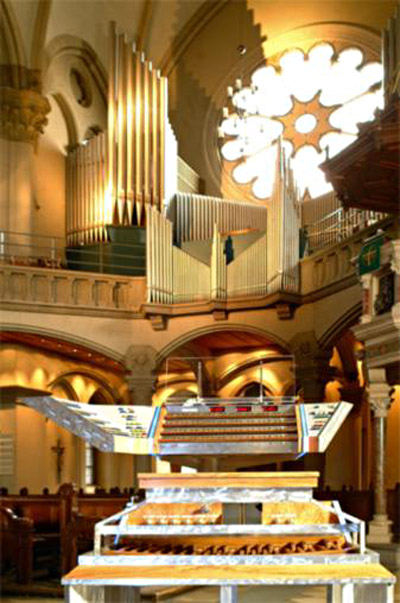
The classical church organ of St. Lucas church in Munich, Germany was equipped with Midi system so a new
futuristic console on audience level could be operated in parallel to
the historic console at the organ.
Here is the short description of this system:
- 4 manuals
- 1 pedalboard
- 2 virtual manuals
- 72 stops
- 23 couplers/sub-couplers/super-couplers
- 2880 memory presets, organized in 5 segments (1 common segment plus 4 - player-owned segments accessible thru key) banks allowing different players to keep their own presets without interfering with other's presets
- 40 Crescendo banks, each 30-steps
- 30-steps programmable Crescendo
- 30-steps Swell
- LED numeric display for Bank:Preset
- LED numeric display for Crescendo
- LED bargraph display for Swell
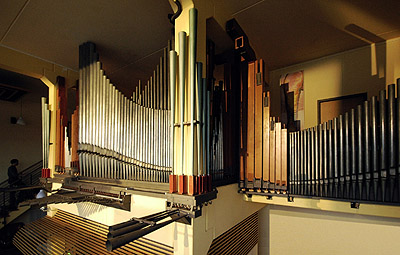
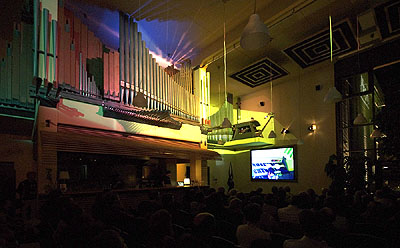
We are proud to announce that probably the biggest (1500 pipes!) private organ in Europe, built in a office facility in Munich was equipped with custom system made by us. The opening took place on 21st of April 2006 (lower photo) and the concert was held twice due to great interest and limited space of 250 seats.
An unique Universal Rank Routing concept was implemented in MIDI decoders for this system allowing user-defined stops routing/processing in decoders theirselves.
Short system description follows:
- 2 manuals (one with second touch)
- 1 pedalboard
- 2 virtual manuals
- 86 stops
- 10 couplers/solo-couplers
- 2880 memory presets, organized in 5 segments (1 common segment plus 4 - player-owned segments accessible thru key)banks allowing different players to keep their own presets without interfering with other's presets
- 40 Crescendo banks, each 30-steps
- 30-steps programmable Crescendo
- 30-steps Swell
- LED numeric display for Bank:Preset
- LED numeric display for Crescendo
- LED bargraph display for Swell
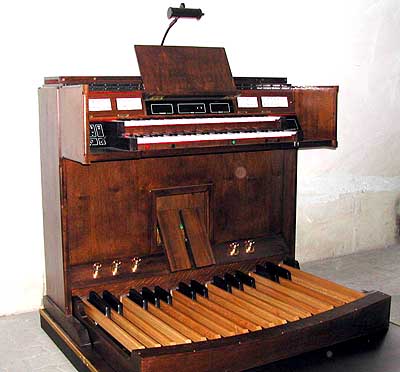
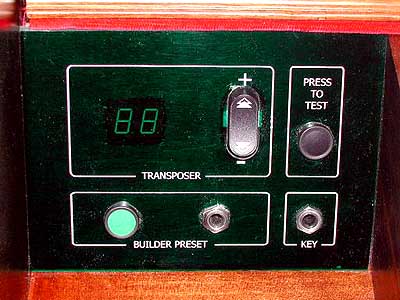

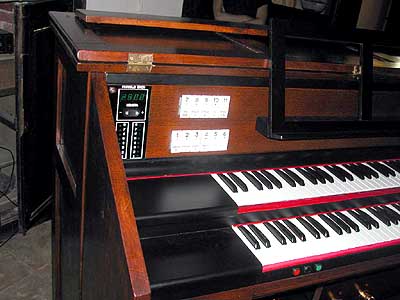


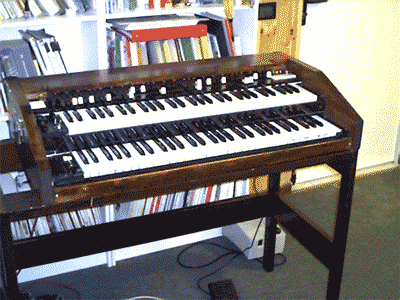



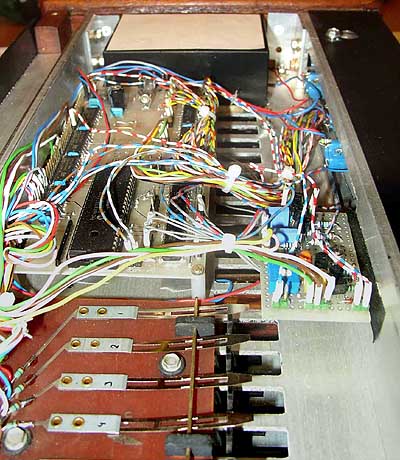
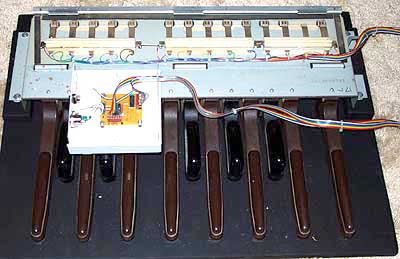

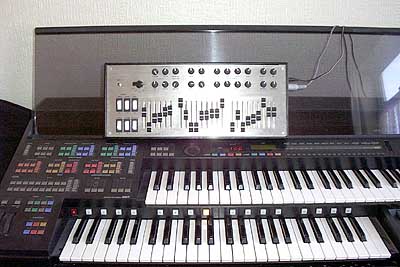

The first of them is pictured here.


Still another perfect B3-mini-clone crafted by Wolfgang Deffner.Three drawbar sets, single keyboard, control switches and potentiometers - all scanned by b4ce1 unit (seen at the far left side).

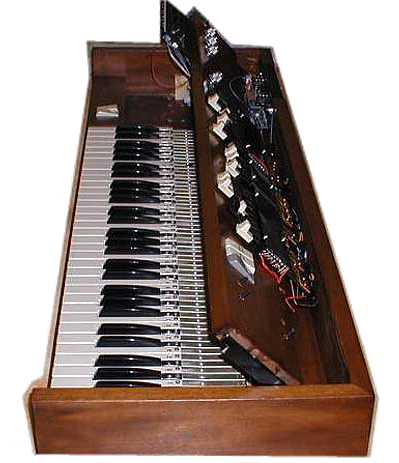

An real Hammond B3 turned into B4 using b4ce1
(board seen in centre of upper picture).
Whole PC is hidden under the real B3 surface.
A masterpiece by Jude Kelley


An hybrid organ, built by James Whitemyer including three generations of tone-producing hardware - pipes (7 ranks & 13-note chime), analog electronic sounds, and digital synthesizers, whith mpc64xr and mpc40x MIDI encoders (top photo), scanning one of organ manuals and pedalboard.
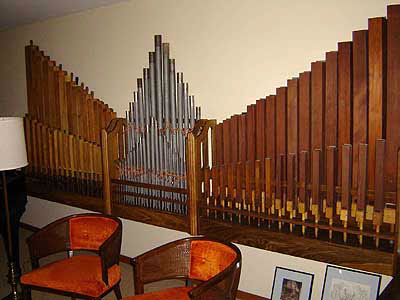
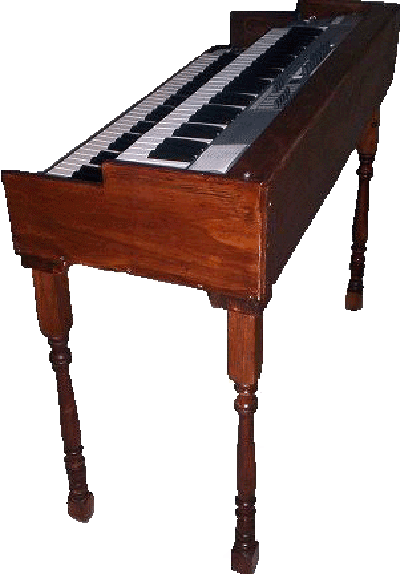

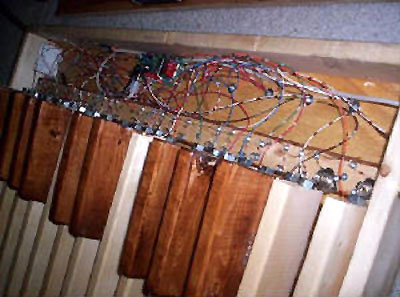
An mkc-mg was used for scanning the pedalboard.
Martin's site

Small single-manual, but real pipe organ for home use. The interface between the manual and pipe chest is MIDI. This allowis both using the keyboard as generic MIDI keyboard controller, as well as controlling pipes from external MIDI controllers/sequencers.
Chris used one mpc64xr for MIDI-fying the manual, and two mdec64ddp for MIDI-fying the pipe chest.




Quite unusual MIDI device built by Christopher: MIDI Ladder.The Ladder can be used for musical performance as well as for controlling multimedia systems. An mkcv64cs unit was used in this project.
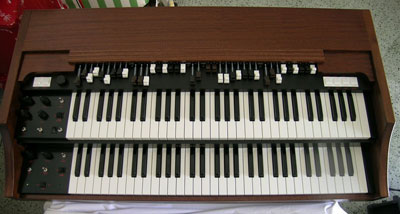

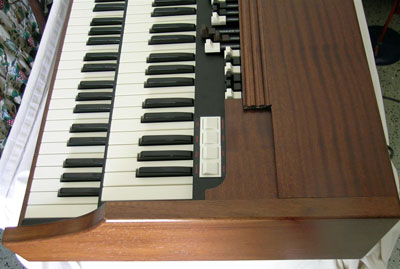
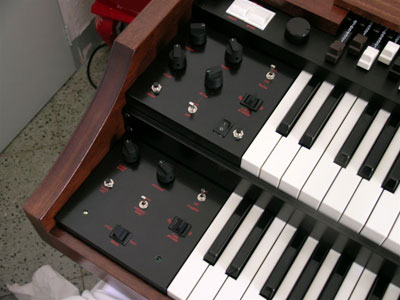
"Santi Bailor 2" - another Hammond clonning masterpiece. The "Santi Bailor" instrument - originally developed by Claudio Zulian (Italy) - was replicated by Giuseppe, using b4ce1 and bke-cz (custom unit designed for Claudio Zulian).

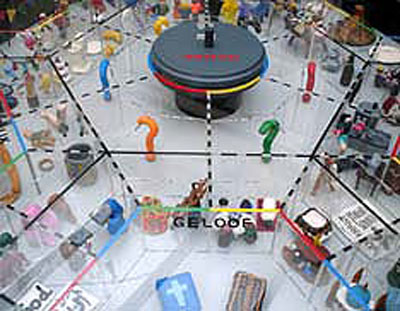

Two young designers Ilone Bloemen and Shirley Clever from Netherlands created a new multi-cultural, multi-media game called Remini. They implemented few of our products (MIDI encoders and decoders) in this installation. More information on Remini can be found on its original site:
www.remini.nl
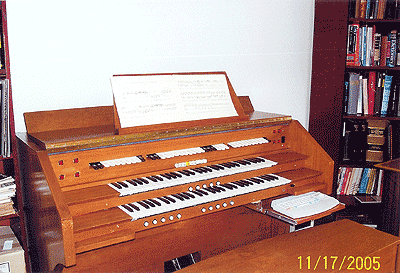
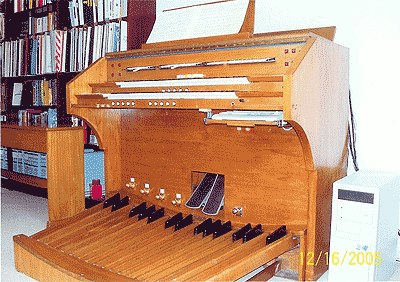

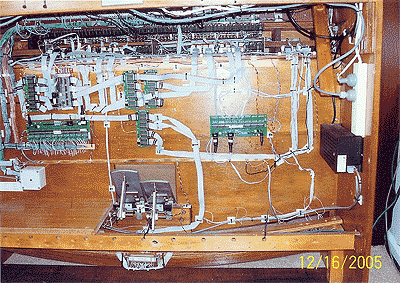
A very passionate and patient man built full organ console for controlling the famous Hauptwerk virtual organ by Martin Dyde. The console has two manuals, pedalboards, motorized stops, lights etc.





An blues-man with very strong engineering skills built an black Hammong.
There is entire PC in this consolle, runnig B4 virtual organ software by Native Instruments. b4ce1 unit is used for MIDI-encoding manuals, drawbars and other controls.




Another black Hammond clone built by Jurgen and his cousin Holger. This time they used the synth part of Roland VK7 plus two waterfall-style keyboard from Doepfer installed their originally-built wooden console, adding an b4ce1 encoder to scan manuals. They named the instrument BeKo.
More information (in German language) can be found on Holger's site:
http://www.holgerkoch.org
They have special page on site dedicated to BeKo project:
http://www.holgerkoch.org/data/main/gear/beko.htm

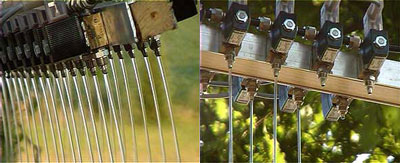

This preformance designer and artist does unusual art projects. Initially he designed an musical coat called "de Vechtjas" using an mpc40 unit.
Later he designed an even more exotic project called "Binary Rain" where he is controlling water drops using MIDI sequencers. An mdec64br unit is implemented in this installation that is driving electric water valves.
More pictures, videos and and information about this and other Mathijs' projects can be found here:
Mathijs' site:
http://www.wittemuizen.nl/art/binabui/index.php
Old site:www.reanimation.nl/druppel.html
Robodock festival site: www.robodock.org


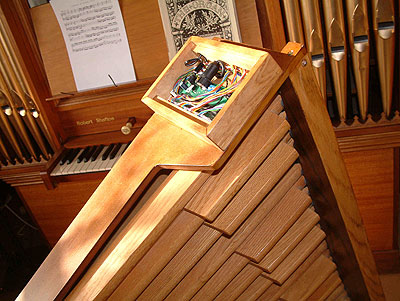
Nick wanted to add pedalboard to his small Shaftoe single-manual, 4-stops pipe organ. He wanted to use the pedalboard for controlling an additional Roland D110 synth, loaded with pipe organ sounds, thus adding more stops. For this purpose he purchased an old pedalboard, refinished it and installed an mpc40x in it.



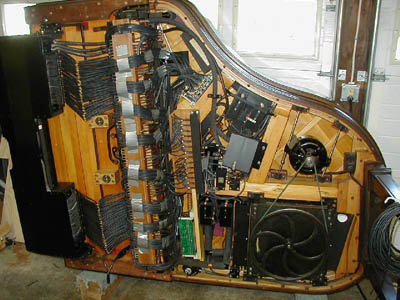
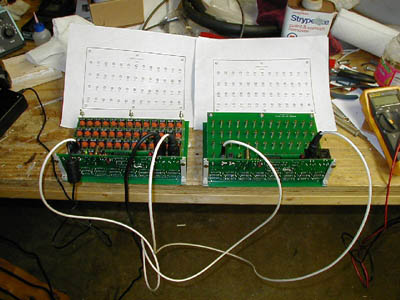
Bob designed his own MIDI decoders with heavy duty drivers, using customized mdec64br microcontroller chips. These decoders were implemented for turning an pneumatic Mason & Hamlin Ampico B player piano into MIDI controllable player piano. Originally playing pieces from piano rolls, now the instrument can be played from PC under MIDI control using WindPlay software by Richard Brandle. The first picture shows the instrument prior to installation of MIDI interface. The second one shows the instrument after installation. The last picture shows the MIDI decoders themselves (one of them is also seen on second picture as green object).
More pictures of Bob's work can fbe found on his page on e-Valves site.
E-Valves site: http://members.shaw.ca/smythe/e-valves.htm
Bob's page on e-Valves: http://members.shaw.ca/smythe/hunt.htm
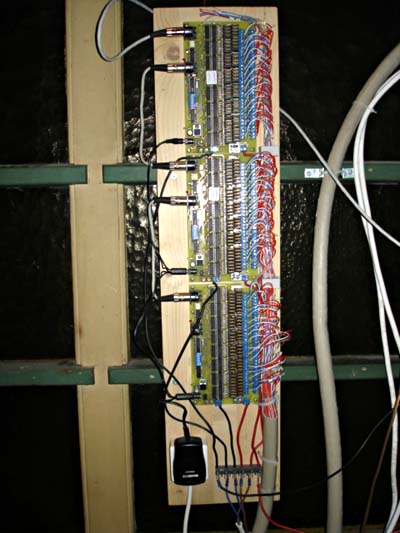

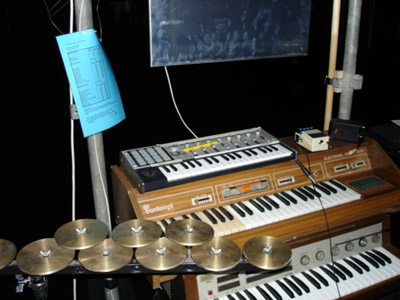

The old church organ built 1924 in Vermeulen, Netherlands was equipped by Jan
with MIDI interface, but shortly after this the church was decommissioned.
Currently the facility is rented by Dutch National Theatre (Het Nationale Toneel)
to be used as stage for thier performance of the 2000 years old Greek Play
called Oresteia (458 B.C.). The performance will take place between
March 31st and May 27th, 2006. The organ itself is integrated in this performance.
There are two consoles - the main one and the remote one used for controlling the organ
during theatre performances.
The theater's site can be visited here:
http://www.oresteia.nl/index.html
The pictures from stage preparations can be seen here:
http://www.oresteia.nl/index_dagboek.html
We'd be happy to put few of them in this gallery.
